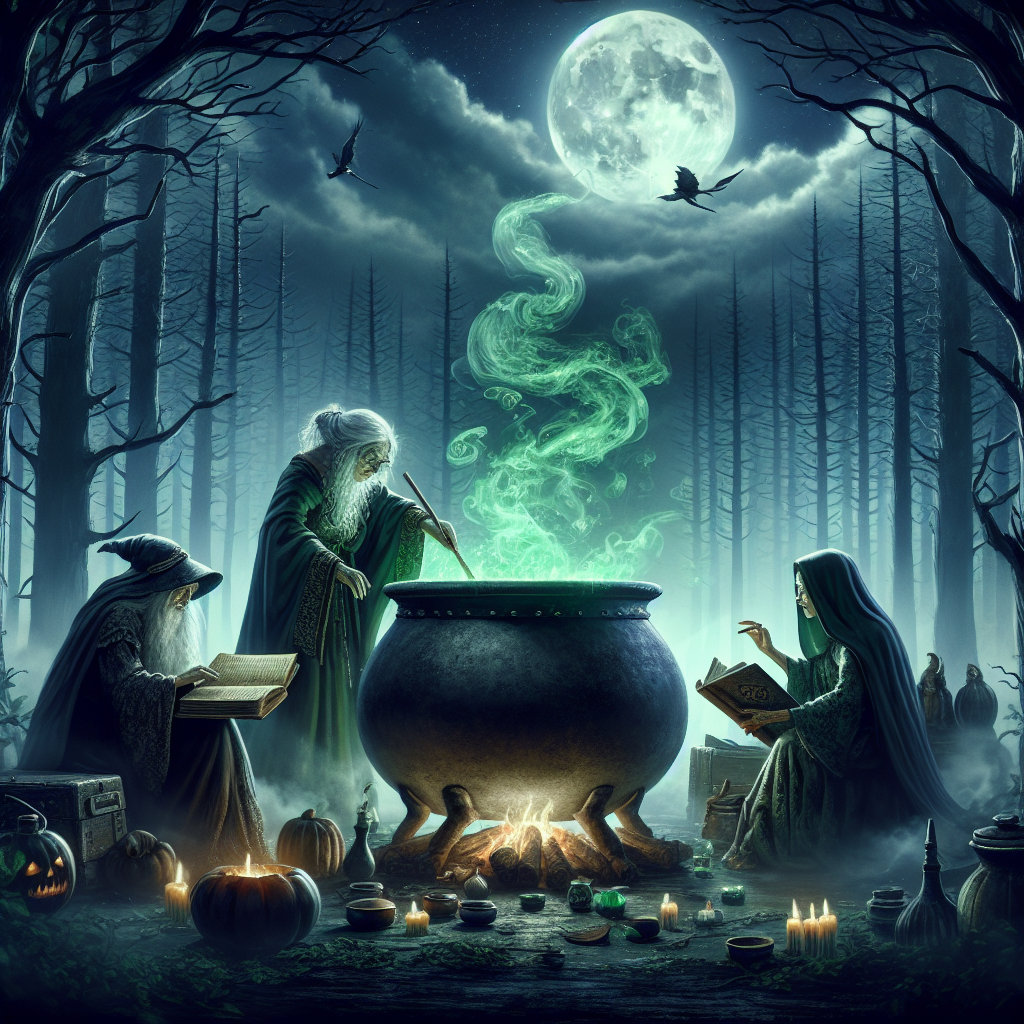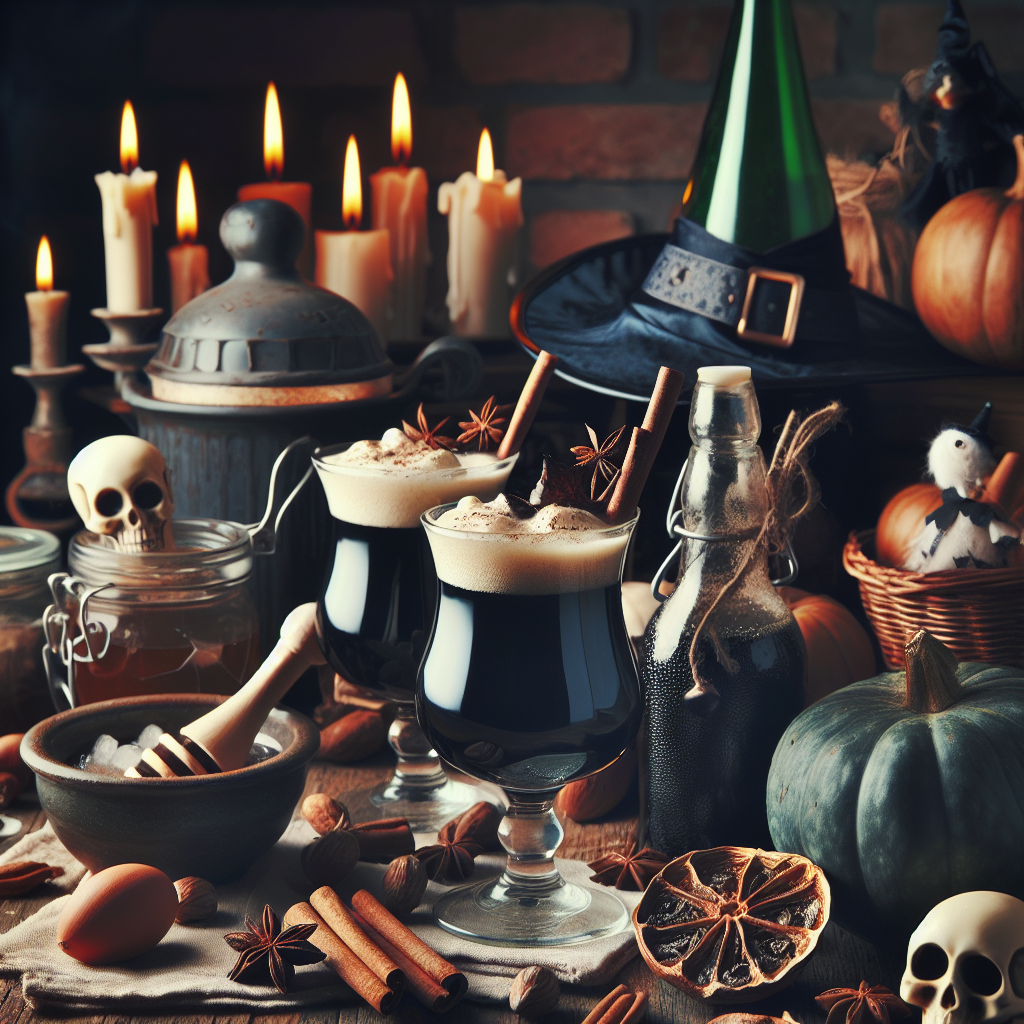As an Amazon Associate I earn from qualifying purchases.

During the Middle Ages, any woman who grew herbs, owned a cat, or had a mole was at risk of being accused of witchcraft. One of the enduring cultural images tied to this unfounded fear is the witches’ brew, a magical potion prepared in a cauldron. This stereotypical picture of a witch hunched over a bubbling pot, chanting incantations and adding vile ingredients, has intrigued audiences throughout history. The secret recipe for this witches’ brew is more than just a cultural image; it carries deep historical and magical significance, an intriguing blend of folklore, herbalism, and superstition that continues to captivate our modern-day imagination.
The recipe for witches’ brew traces its roots back to an ancient world deeply entwined with nature. Witchcraft, in its original form, was merely the use of natural substances to cure ailments. This practice is now known as herbalism. The witches’ brew was, therefore, essentially a concentrated herbal remedy. While Hollywood and folklore have embellished the brew with ingredients like eye of newt and wing of bat over the years, the original recipe was probably nothing more sinister than potent herbs boiled together in a pot.
The early medieval era was a tumultuous time, where a fear of witches and the unknown pervaded society. This fear was largely spread by the church, which conflated the use of natural remedies with devil worship. As a result, women who practiced herbalism were prosecuted and the concept of the witches’ brew took a dark turn. People believed that these brews contained malicious ingredients meant to curse or harm others, rather than heal.
Researchers studying the history of witchcraft have found that certain ingredients mentioned in historical texts associated with witches’ brew reveal fascinating insights into the herbal remedies of the time. For instance, the “eye of newt” is believed to refer to the seed of a mustard plant, and “toe of frog” likely represented buttercup. It is argued these ingredients were code names to protect the secrecy of medicinal recipes.
Today, the notion of the witches’ brew has multiplied in significance across many fronts. With growing interest in natural remedies and holistic healing, people are becoming more conscious of the healing properties of herbs – a knowledge witches were persecuted for in the Middle Ages. Furthermore, the image of the witches’ brew has deeply embedded itself in popular culture, particularly during Halloween celebrations. Research indicates that around 25 million gallons of cider, often now associated with the idea of a witch’s brew, is consumed every October.
In a somewhat ironic twist, the modern scientific community is increasingly acknowledging the medicinal properties of many ancient herbal remedies. Studies have revealed that some of these remedies show promise in treating modern ailments, from stomach disorders to cancer. Could these be the secrets the witches were accused of hiding in their controversial brew? The curious mind could only speculate, as the mysteries of the witches’ brew continue to unfold.
What are the Historical and Mystical Elements of a Witches’ Brew? Insider’s guide to its Secret Recipe
Beyond mere hocus pocus and Hollywood clichés, the witches’ brew encapsulates centuries’ worth of history, mysticism, and folklore. Witches’ brew refers to a symbolic concoction typically associated with Halloween tales or ancient witchcraft practices. Its contents aren’t mere random ingredients, but each element represents a magical symbol or historical ritual. Delving into its secret recipe, we unravel a fascinating intersection of cultural magic practices, historical symbolism, and the human fascination with the unknown. Stay on to uncover the intriguing world of witches’ brew – its historical significance, the magical implications of its varying ingredients, and its enduring cultural influence.
Historical Roots of Witches’ Brew
The witches’ brew holds a fascinating place in history, transcending cultures as a symbol of supernatural power and magic for centuries. Throughout European folklore, witches’ brew is often associated with the notorious, green, bubbling mixture known to be a tool of witches for casting spells and manipulation.
However, in its historical roots, witches’ brew was not as ominous as it may seem. In the Middle Ages, particularly in Scotland and England, women known as “wise women,” who were essentially the doctors of the time, used their knowledge of herbs and plants to create curing potions for the sick in their respective communities. These concoctions were commonly called “witches’ brew.”
The Magical Ingredients of Witches’ Brew
The secret recipe for witches’ brew has been the subject of speculation and intrigue for centuries. Often portrayed as a mysterious potion filled with outlandish ingredients like “eye of newt” or “wing of bat,” the witches’ brew was in reality more akin to a medieval meal made with common household ingredients.
In old recipes, “eye of newt” and “wing of bat” were simply colorful names for mustard seeds and holly leaves respectively. Hence, witches’ brew recipes often included herbs like mugwort, belladonna, and datura for their mild hallucinogenic properties to induce trances and visions among the users, phrasing them as animal parts for a poetic touch. The brew could also contain parts of plants like hemlock and deadly nightshade, well-known for their toxic effects, giving rise to the ferocious reputation of witches’ brew.
The Witches’ Brew of Today
Today, the witches’ brew stands as a metaphorical concept regarding a concoction of potent and powerful elements. In popular culture, it’s synonymous with Halloween and often seen as a playful element at parties, made as a fun green punch with a swirl of dry ice for a spectacularly supernatural appeal.
Captivatingly, the use of witches’ brew as herbal mixtures for well-being has made a comeback in alternative medicine circles. This modern-day witches’ brew, also known as “green juice,” contains a combination of various nutrient-rich herbs and vegetables and is believed to provide a host of health benefits.
Statistical Insights
Interestingly, the market capitalism of witches’ brew and other magic-themed products shows a significant upward trend. According to Grand View Research, the global organic herbal medicines market size was valued at USD 8.6 billion in 2020 and is expected to expand at a compound annual growth rate (CAGR) of 8.6% from 2021 to 2028. This advantageous market statistic indicates the bewitching power of witches’ brew remains influential in everyday life and society, even in the 21st century.
1. What is the historical significance of witches’ brew?
The witches’ brew has roots strong in old European folklore, mainly associated with the practice of witchcraft during the Medieval age. The brew was believed to contain mystical components that rendered powers to perform magic and spells. It’s a symbol of the underground, rebellious practices that were performed in defiance of the Church’s dominance and its strict beliefs against witchcraft.
2. Are there any typical ingredients for a witches’ brew?
The composition of witches’ brew varies widely in folklore. It often includes herbs, roots, and animals’ body parts, many of which are symbolic or metaphorical. For instance, ingredients mentioned in Shakespeare’s Macbeth, like “eye of newt,” actually correspond to common herbs and plants. Traditionally, all these components were believed to enhance the practitioner’s magic potency.
3. Can witches’ brew be used for actual cooking?
While the traditional witches’ brew is surrounded by mystique and superstition, it cannot be used for regular cooking. The historical ingredients have symbolic meaning tied to witchcraft and spell-casting. However, many contemporary ‘witches’ brew’ recipes exist, often created for Halloween festivities, using common and edible ingredients.
4. Was witches’ brew really used for magic?
In folklore and historical accounts, witches’ brew was believed to be a magical concoction used to conjure spirits, cast spells, and create other supernatural effects. However, this is widely regarded today as mythology and superstition. There is no scientific evidence to support the claim that witches’ brew, or any other form of witchcraft, can produce magic.
5. Is witches’ brew dangerous?
The traditional witches’ brew, as portrayed in folklore, often included toxic or harmful ingredients. However, these historical recipes are not used today. Instead, a more symbolic understanding of these ingredients is used for modern-day rituals or celebrations.
6. Are there any cultural symbols hidden in the witches’ brew?
Yes, many ingredients used in witches’ brew recipes serve as cultural symbols related to witchcraft and pagan practices. For instance, the “eye of newt” mentioned in Macbeth is believed to symbolize transformation and rebirth, as newts can regenerate body parts.
7. What role does witches’ brew play in modern witchcraft?
In modern witchcraft, also known as Wicca, the concept of witches’ brew may be used symbolically, for ritual purposes or for the creation of herbal remedies. These practices are intended to connect practitioners with nature and spirituality, rather than producing supernatural effects.
8. What’s the connection between witches’ brew and Halloween?
Witches’ brew has long been associated with Halloween due to its ties with witchcraft. The concept of witches cooking up magical potions fits into the spooky and mystical theme of the holiday. Today, “witches’ brew” is often seen as a fun and creepy concoction made for Halloween parties.
9. Do real-life witches use witches’ brew?
Practitioners of Wicca and other forms of modern witchcraft do not usually create traditional witches’ brew. They may, however, use the concept symbolically in their rituals or produce herbal preparations. It is important to understand that modern witchcraft is a spiritual practice, not linked to the dangerous or malevolent activities sometimes associated with witches in folklore.
10. Is making a witches’ brew illegal?
No, creating a witches’ brew is not illegal, as long as it does not include any dangerous or harmful substances. Wicca and other forms of modern witchcraft are recognized religions, and their practices are protected under freedom of religion laws. However, this does not mean that all activities performed under the banner of witchcraft are legal.
Unveiling the Brew’s Mystique
In essence, the lore surrounding witches’ brew is an amalgam of historical, cultural, and supernatural elements that underscore the brewing process as not merely a culinary endeavor, but a magical ritual. The brew, historically and symbolically related to potent herbalism and native healing practices, serves as an emblem of the witch’s arcane knowledge, weaving together the threads of mysticism, transformation, and agency. The brew’s ingredients, entailing a diverse and often misunderstood range of items, further compound its enigmatic allure, featuring unique items such as “eye of newt” and “toe of frog”, which are often more correspondences to common herbs rather than literal ingredients.
The rituals involved in creating witches’ brew additionally serves as a symbolic conduit for harnessing and channeling magical energies, with the interplay of the natural elements and the alignment of celestial bodies having significant bearing on the brew’s efficacy. At its core the brew acts as both a metaphysical reflection and expression of the witch’s intent, making it a potent tool of witchcraft. As such, with richer awareness and understanding, the traditional perception of witches’ brew transitions from a spooky Halloween trope into a complex and fascinating peek into the profound realms of historical herbalism, ancient practices, and the enchanting world of magical lore and witchcraft.
Amazon and the Amazon logo are trademarks of Amazon.com, Inc, or its affiliates.


